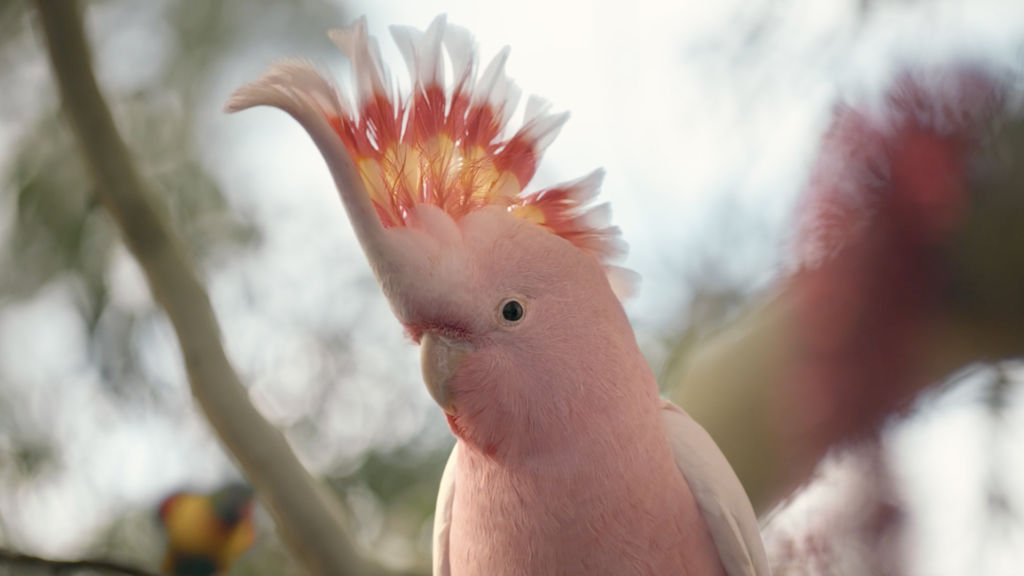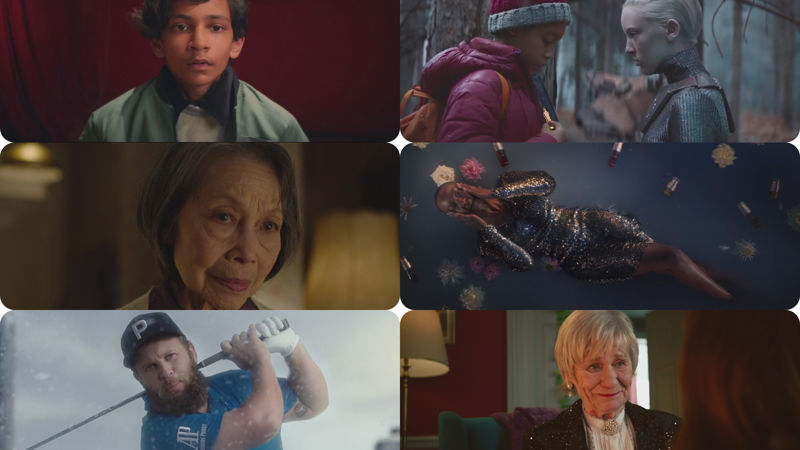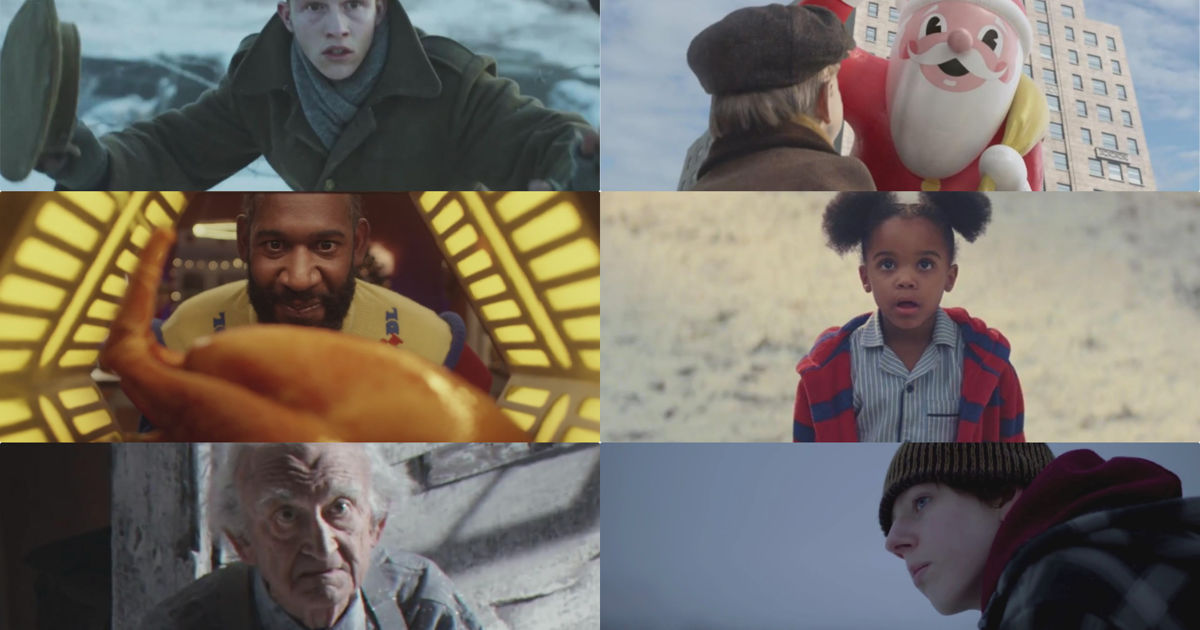The Christmas ads and what they’re really saying
You may think festive ads are all about expensive gifts, overfed families and gaudy decorations but, says The Moon Unit, there are hidden depths to these Christmas confections that tackle human concerns such as the fear of isolation, the desire for freedom and meaningfulness, and our fear of death.
You can tell a lot about a culture from its advertising. Ever looked through an old newspaper? The headlines may tell you what was going on in the world, but the ads tell you what was happening in people’s hearts. People’s deeper concerns. Their fears and desires.
The four areas that Christmas ads suggest may be concerns for our society are fear of isolation, a desire for freedom, a desire for meaningfulness and our fear of death.
Christmas ads are full of these deeper meanings. The products they feature are incidental – instead, Christmas ads are trying to make us feel something (if only brands did this all year round!). They are trying to resonate and, for that reason, they give us an excellent window into the values and concerns of our culture.
The four areas that Christmas ads suggest may be concerns for our society are fear of isolation, a desire for freedom, a desire for meaningfulness, and – although this idea might on the face of it seem incongruous within the festive context of Christmas – our fear of death.
Credits
powered by
- Agency The Monkeys/Melbourne
-
- Director Glendyn Ivin
-
-
Unlock full credits and more with a Source + shots membership.
Credits
powered by
- Agency The Monkeys/Melbourne
- Director Glendyn Ivin
- CEO Paul McMillan
- Executive Planning Director Michael Derepas
- Chief Creative Officer Ant Keogh
- Art Director Joe Sibley
- Head of Production Romanca Jasinski
- Producer Katie Wellbelove
- Producer Emma King

Credits
powered by
- Agency The Monkeys/Melbourne
- Director Glendyn Ivin
- CEO Paul McMillan
- Executive Planning Director Michael Derepas
- Chief Creative Officer Ant Keogh
- Art Director Joe Sibley
- Head of Production Romanca Jasinski
- Producer Katie Wellbelove
- Producer Emma King
Above: A lonely cockatoo in Australia Post’s 2020 ad raises and then resolves the issue of isolation at Christmas.
Let’s start with the issue of isolation. Christmas in ads is a time when families come together and loneliness is vanquished. The festive season has always been a period when we feel heightened sympathy for those who find themselves alone, since it is considered especially depressing to be ‘on your own at Christmas'. But the theme draws particular resonance when you consider that social isolation is a major issue in our society in general, not just at Christmas. We are increasingly living alone, or at least in smaller units.
The festive season has always been a period when we feel heightened sympathy for those who find themselves alone, since it is considered especially depressing to be ‘on your own at Christmas'.
In Canada, for example, average household size has plunged from 12.5 persons per household (in 1851) to 2.5 today. Robert Putnam’s 2000 book Bowling Alone charted the massive reduction in social contact experienced by the typical American.
Christmas ads that address isolation usually do so by first raising the issue, and then resolving it. Examples of ‘isolation resolved’ Christmas spots include John Lewis’s 2015 Man on the Moon ad [below], with its overt anti-loneliness message, last year’s Australia Post commercial [above] featuring a love-deprived cockatoo, and this year’s festive spot from Gap out of the US, in which a sad Katy Perry, apparently isolated by her fame, reconnects with other people at a Christmas fashion shoot.
John Lewis – John Lewis: Man on the Moon
John Lewis & Partners and Waitrose & Partners – Excitable Edgar
Above: John Lewis's anti-loneliness spot from 2015 and last's year's Excitable Edgar, the central theme of which was acceptance.
But the theme can also take more subtle forms, around issues not just of loneliness, but acceptance.
Take last year’s John Lewis ad, featuring Edgar [above], an excitable dragon who has become an outcast. Like a sheet metal worker entering the information age, his fire-breathing skills are seen as too brute and unsubtle. However, he is able to redeploy his ability to setting the Christmas pudding alight. After his successful ‘re-training’, he is accepted by the community.
Apple addresses the fear that the encroachment of modern technology will separate us from each other. The genius is that it turns the argument on its head.
Although one is set in a fantasy medieval England and the other in a modern America, there is a strong parallel between this commercial and Apple’s highly-regarded 2013 Christmas effort, Misunderstood [below], in which a teenager is seemingly too preoccupied by his iPhone to engage with his family gathered for the holiday, but is later revealed to have been working on a movie about the event. But both spots deal with isolation. In the case of the Apple ad, it addresses the fear that the encroachment of modern technology will separate us from each other. The genius of this ad is that it turns the argument on its head, demonstrating that technology can be a tool for connection not detachment.
It’s interesting to note that in both these ads, the outcast is only accepted by their community once they have demonstrated a skill. In today’s culture, it seems, acceptance cannot be granted unconditionally.
Credits
powered by
- Agency TBWA Chiat Day/Los Angeles
- Production Company Park Pictures
- Director Lance Acord
-
-
Unlock full credits and more with a Source + shots membership.
Credits
powered by
- Agency TBWA Chiat Day/Los Angeles
- Production Company Park Pictures
- Director Lance Acord
- CD Drew Stalker
- CD David Zorn
- CD Chris Ribeiro
- Exec CD Eric Grunbaum
- Chief Cr Off Duncan Milner
- Producer Diana Parada
- Producer TBWA Chiat Day/Los Angeles
- Producer Mary Ann Marino
- DP Lance Acord
- Editor Jared Coller
- Sound Design Tom Stamatio
- Editor Tom Muldoon
- Production Designer Greg Loewen
- CD JD Jurentkuff
- Producer Aristides McGarry
- Song "Have Yourself A Merry Little Christmas" Cat Powers
- Producer Laura Keseric

Credits
powered by
- Agency TBWA Chiat Day/Los Angeles
- Production Company Park Pictures
- Director Lance Acord
- CD Drew Stalker
- CD David Zorn
- CD Chris Ribeiro
- Exec CD Eric Grunbaum
- Chief Cr Off Duncan Milner
- Producer Diana Parada
- Producer TBWA Chiat Day/Los Angeles
- Producer Mary Ann Marino
- DP Lance Acord
- Editor Jared Coller
- Sound Design Tom Stamatio
- Editor Tom Muldoon
- Production Designer Greg Loewen
- CD JD Jurentkuff
- Producer Aristides McGarry
- Song "Have Yourself A Merry Little Christmas" Cat Powers
- Producer Laura Keseric
Above: Apple's 2013 spot, Misunderstood, deals with isolation and how technology can bring us together.
Another societal concern that shows up in Christmas ads is our desire for freedom. Our lives used to be highly structured. Most men and women conformed to strict gender and social roles. Today, we can quite easily change jobs, and gender roles are more fluid. But our lives are still heavily constrained by family and employer obligations.
Many Christmas ads find power in portraying Christmas as a time of greater licence than our regular daily existence. What better expression of the sheer joy of freedom has been captured than the trampolining of Buster the Boxer in John Lewis’s 2016 Christmas ad [below]? The Gap’s famous Michel Gondry-directed holiday ads were similarly bursting with freedom.
The decline of religion has left many of us searching for meaning in our lives.
A third concern addressed by Christmas ads is our desire for meaning. The decline of religion has left many of us searching for meaning in our lives. In a Christmas context, this theme often seems to be expressed as the search for a meaningful gift.
The 2018 Boy And The Piano John Lewis ad is a good example. The commercial shows his family giving young Elton John a piano, which changes his life in ways we all know. The story is about the power of a Christmas gift to bring meaning to a person’s life. And the 2008 John Lewis Christmas ad, From Me to You [below], shows a sequence of people who each receive a gift that is particularly meaningful to them. For example, a dog with long fur is given a hairdryer.
John Lewis – John Lewis: Buster the Boxer
John Lewis – From Me To You
Above: Urban wildlife experiencing the freedom we would all wish to enjoy, in John Lewis’s Buster the Boxer, while Michel Gondry's Gap spots from 1999 are 'bursting with freedom'.
The fourth and final concern that Christmas ads seem to address is our fear of death. Arguably, our culture’s annual celebration of Christmas itself plays into the false (but comforting) notion that life is cyclical, rather than a linear journey.
Death is a subject far too heavy for most brands to address. But the 2013 John Lewis Christmas ad, The Bear and the Hare, seems to do so, albeit covertly. This film tells the story of a hare who – feeling sorry for his friend, a bear who always misses Christmas since he has to hibernate – decides to gift him an alarm clock. The bear, who all the animals had thought was lost to them, awakens, returns, and is able to participate in the merriment of Christmas. One reading of the ad is that it’s a resurrection story. Death is often referred to as ‘the long sleep’, and in showing us that the bear’s hibernation can be brought to an end by a thoughtful Christmas gift, the ad may be expressing our desire to triumph over death.
Death is a subject far too heavy for most brands to address. But the 2013 John Lewis Christmas ad, The Bear & the Hare, seems to do so, albeit covertly.
Sainsbury’s 1914-set Christmas is For Sharing ad [below] told the story of how the Christmas truce was a respite from the slaughter of the Western Front. It literally put death on hold. This year’s Lidl ad, Always, [below] depicts a family enjoying Christmas today and then hundreds of years into the future – they appear to be immortal. Macy’s 2016 Old Friends ad [bottom] explicitly addresses death. A Santa blimp in the Thanksgiving Day parade sees a boy in the crowd, and winks at him. Thus begins a tradition: the boy becomes a man, and finally an old man, and Santa looks forward to seeing him at the parade every year. When eventually the old man is no longer there, the implication is clear – he has died. The Santa blimp leaves the parade and flies across the US, eventually tracking down his old friend at home, for a poignant reunion. The anxiety caused by the thought of death has been defused.
Sainsbury's & Royal British Legion – Christmas Is For Sharing
Lidl – Always
Above: Sainsbury's and Macy's separately dipped a toe into the taboo waters of death, even if they did it covertly.
And German supermarket brand Edeka went viral in 2015 with Coming Home, the tale of an elderly man who is unable to get his family to visit him for the festive period. When they all receive word that he has died, the family gathers at his home for the funeral… only for the gentleman himself to appear, very much alive, and having prepared a Christmas meal for them all, thus showing that the spirit of Christmas togetherness can trump even death.
If a Christmas ad evokes such powerful emotions that, for 60 seconds at least, it can help us put aside such deep-seated concerns, then that’s a hugely impressive achievement.
It may be that none of the individuals involved in the creation of these fantastic commercials could explain why they have resonated so strongly. They might scoff at the suggestion they were addressing our society’s existential anxieties. Nevertheless, the power of these ads undeniably stems from somewhere, and it may well be from their ability to address our culture’s fear of isolation, desire for freedom, yearning for meaning, and fear of death.
And if a Christmas ad evokes such powerful emotions that, for 60 seconds at least, it can help us put aside such deep-seated concerns, then that’s a hugely impressive achievement.
Credits
powered by
- Agency Bartle Bogle Hegarty (BBH) New York/United States of America
- Production Company Biscuit Filmworks
-
-
-
Unlock full credits and more with a Source + shots membership.
Credits
powered by
- Agency Bartle Bogle Hegarty (BBH) New York/United States of America
- Production Company Biscuit Filmworks
- Grade MPC Los Angeles
- Editing Company Work Editorial, New York
- Sound Design Sound Lounge
- Visual Effects MPC NY
- Editor Stewart Reeves
- Director of Photography Simon Duggan
- Copywriter Hemant Anant Jain
- Executive Producer Rick Jarjoura
- Executive Producer Meghan Lang
- Executive Producer Camila De Biaggi
- Chief Creative Officer Ari Weiss
- Managing Director Justin Brukman
- Head of Production Kate Morrison
- Director Noam Murro
- Producer Erica Thompson
- Producer Charlotte Woodhead
- Producer Sari Resnick
- Creative Director Shannon McGlothin
- VFX Supervisor Ashley Bernes
- Colourist Mark Gethin
- Creative Chairman John Patroulis
- Colour Producer
- Colour Producer Rebecca Boorsma
- Senior Producer

Credits
powered by
- Agency Bartle Bogle Hegarty (BBH) New York/United States of America
- Production Company Biscuit Filmworks
- Grade MPC Los Angeles
- Editing Company Work Editorial, New York
- Sound Design Sound Lounge
- Visual Effects MPC NY
- Editor Stewart Reeves
- Director of Photography Simon Duggan
- Copywriter Hemant Anant Jain
- Executive Producer Rick Jarjoura
- Executive Producer Meghan Lang
- Executive Producer Camila De Biaggi
- Chief Creative Officer Ari Weiss
- Managing Director Justin Brukman
- Head of Production Kate Morrison
- Director Noam Murro
- Producer Erica Thompson
- Producer Charlotte Woodhead
- Producer Sari Resnick
- Creative Director Shannon McGlothin
- VFX Supervisor Ashley Bernes
- Colourist Mark Gethin
- Creative Chairman John Patroulis
- Colour Producer
- Colour Producer Rebecca Boorsma
- Senior Producer
)























